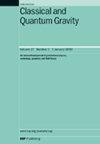大黄蜂引力下带电球对称黑洞的粒子动力学和光学外观
IF 3.7
3区 物理与天体物理
Q2 ASTRONOMY & ASTROPHYSICS
引用次数: 0
摘要
本文研究了大黄蜂引力下带电黑洞(BHs)的粒子动力学、阴影和光学外观。首先,通过类时测地线分析发现,洛伦兹破坏参数l和电荷参数Q对有效势峰的影响相反,最内层稳定圆轨道半径随着黑洞参数l和Q的增大而减小;我们还探讨了粒子能量、角动量和开普勒频率的行为。其次,对于零测地线,光子球半径和阴影半径都随着l和Q的增加而减小,并且始终小于Reissner-Nordström黑洞(RNBH)和类史瓦西黑洞。并基于事件视界望远镜合作项目报告的观测数据,利用Sgr A*的阴影半径数据对参数l和Q进行了约束。第三,探讨了三种薄盘吸积模型下带电黑洞的观测特征。结果表明,与RNBH相比,l的增加导致光子环和透镜环的厚度增大。但是,由于它们的范围非常窄,因此贡献很小,观测到的强度主要是由直接排放贡献的。此外,当参数l一定时,对于相同的发射模式,观测到的环强度峰值随着Q的增加而减小,并且始终低于类史瓦西黑洞的相应值。这些发现有助于根据它们的光学外观来区分大黄蜂带电的黑洞和其他类型的黑洞。本文章由计算机程序翻译,如有差异,请以英文原文为准。
Particle dynamics and optical appearance of charged spherically symmetric black holes in bumblebee gravity
In this paper, we study the particle dynamics, shadow, and optical appearance of charged black holes (BHs) in bumblebee gravity. Firstly, we find that the Lorentz-violation parameter l and charge parameter Q have opposite effects on the peak of the effective potential by analyzing timelike geodesics, and the radius of the innermost stable circular orbit decreases as the BH parameters l and Q increase. We also explore the behaviors of particle energy, angular momentum, and Keplerian frequency. Secondly, for null geodesics, both the photon sphere radius and the shadow radius decrease with increasing l and Q, and are consistently smaller than those of the Reissner–Nordström BH (RNBH) and Schwarzschild-like BH. And based on observational data reported by the event horizon telescope collaboration, we constrain the parameters l and Q by using the shadow radius data of Sgr A*. Thirdly, we explore the observation characteristics of charged BHs under three thin disk accretion models. The results show that, compared to RNBH, the increase of l leads to a greater thickness of the photon rings and lensed rings. However, due to their extremely narrow ranges, the contributions are small, and the observed intensities are mainly contributed by the direct emissions. Moreover, when the parameter l is fixed, the peaks of the observed intensities of rings decrease with increasing Q for the same emission model, and it is always lower than the corresponding value for Schwarzschild-like BH. These findings contribute to distinguishing bumblebee charged BHs from other types of BHs based on their optical appearance.
求助全文
通过发布文献求助,成功后即可免费获取论文全文。
去求助
来源期刊

Classical and Quantum Gravity
物理-天文与天体物理
CiteScore
7.00
自引率
8.60%
发文量
301
审稿时长
2-4 weeks
期刊介绍:
Classical and Quantum Gravity is an established journal for physicists, mathematicians and cosmologists in the fields of gravitation and the theory of spacetime. The journal is now the acknowledged world leader in classical relativity and all areas of quantum gravity.
 求助内容:
求助内容: 应助结果提醒方式:
应助结果提醒方式:


